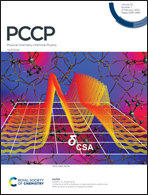In silico capture and activation of methane with light atom molecules†
Abstract
Methane (CH4) can be captured in silico with a light atom molecule containing only C, H, Si, O, and B atoms, respectively. A tripodal peri-substituted ligand system was employed, namely, [(5-Ph2B-xan-4-)3Si]H (1, xan = xanthene), which after hydride abstraction (1+) carries four Lewis acidic sites within the cationic cage structure. In a previous study, this system was shown to be able to capture noble gas atoms He–Kr (Mebs & Beckmann 2022). In the corresponding methane complex, 1+CH4, a polarized Si+⋯CH4 contact of 2.289 Å as well as series of (H3)CH⋯O/CPh hydrogen bonds enforce spatial CH4 fixation (the molecule obeys C3-symmetry) and slight activation. A trigonal-pyramidal Si–CHeq3–Hax local geometry is thereby approached with Hax–C–Heq angles decreased to 103.7°. All attempts to replace the Lews acidic –BPh2 fragments in 1 with basic –PR2 (R = Ph, tBu) fragments indeed increased intra-molecular hydrogen bonding between host molecule and CH4, and thus caused stronger activation of the latter, however ultimately resulted in the formation of energetically favorable quenched structures with short P–Si contacts, making CH4 binding hard to achieve. The electronic situation of two hypothetic methane complexes, 1+CH4 and [(5-tBu2P-xan-4-)3SiCH4]+ (2+CH4), was determined by a set of calculated real-space bonding indicators (RSBIs) including the Atoms-In-Molecules (AIM), non-covalent interactions index (NCI), and electron localizability indicator (ELI-D) methods, highlighting crucial differences in the level of activation. The proposed ligand systems serve as blueprints for a more general structural design with adjustable trigonal ligand systems in which central atom, spacer fragment, and functional peri-partner can be varied to facilitate different chemical tasks.



 Please wait while we load your content...
Please wait while we load your content...